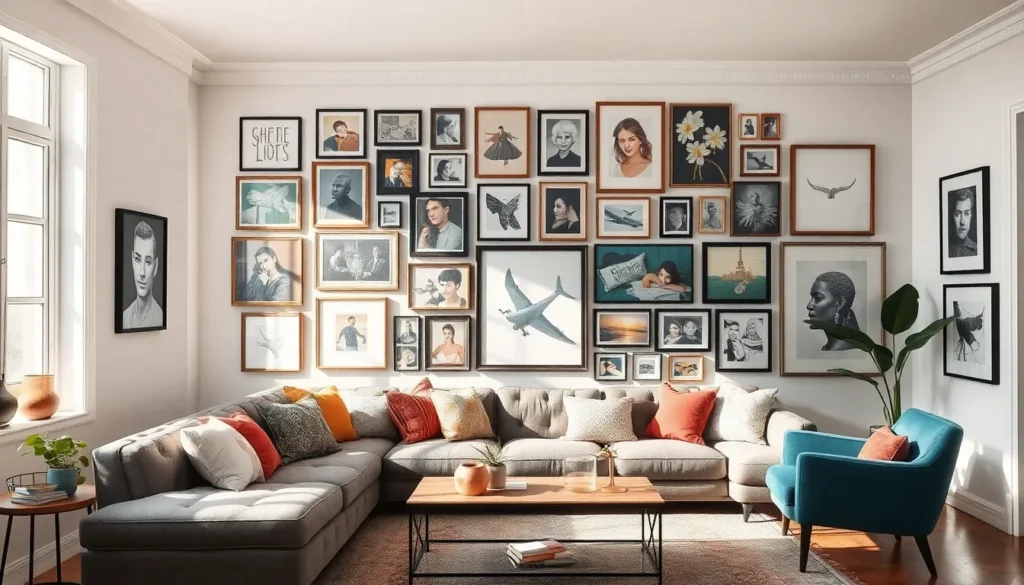Your living room walls don’t have to stay bare and boring. We’ve all walked into a space and felt that something was missing – that spark that transforms a house into a home. Gallery walls are the perfect solution to breathe life into your living room while showcasing your personality and style.
Creating a stunning gallery wall isn’t just about hanging random pictures together. It’s an art form that combines visual balance, personal expression, and strategic design choices. Whether you’re working with family photos, artwork, or a mix of both, the right gallery wall can become the focal point that ties your entire living room together.
We’ll guide you through the most effective gallery wall ideas that’ll transform your space from ordinary to extraordinary. From choosing the perfect layout to selecting complementary frames, you’ll discover how to create a gallery wall that reflects your unique taste while improving your living room’s overall aesthetic.
Create A Cohesive Color Scheme For Your Gallery Wall
Color coordination transforms a random collection of artwork into a polished gallery wall that elevates your entire living room design. We’ve found that establishing a thoughtful color scheme creates visual harmony while allowing individual pieces to shine within the unified display.
Choose A Unified Color Palette
Pick three to four colors maximum to maintain visual coherence across your entire gallery wall. We recommend selecting one dominant color that appears in 60% of your pieces, paired with one or two accent colors for variety. Monochromatic schemes using different shades of blue or gray create sophisticated gallery walls that never overwhelm your living room decor.
Select artwork with similar color temperatures to ensure your pieces work together seamlessly. Warm tones like reds, oranges, and yellows create cozy gallery walls perfect for traditional living rooms. Cool tones including blues, greens, and purples offer modern appeal that complements contemporary furniture and decor elements.
Use white or black frames consistently to tie together artwork with varying color palettes. We’ve observed that uniform framing allows colorful artwork to pop while maintaining the cohesive look your gallery wall needs to succeed.
Balance Bold And Neutral Tones
Distribute vibrant pieces evenly throughout your gallery wall to prevent any single area from becoming too overwhelming. We suggest placing one bold artwork for every two or three neutral pieces to create visual interest without chaos. Strategic placement of colorful art draws the eye around your entire display rather than focusing attention on just one corner.
Ground bright artwork with neutral backgrounds to let your colorful pieces become the focal points they deserve to be. White, cream, or light gray matting provides breathing room around bold prints and paintings. Neutral foundations help vibrant colors appear more intentional rather than random within your living room gallery wall.
Mix different intensities of the same color to add depth without introducing competing hues. We recommend pairing soft pastels with their saturated counterparts to create layered visual interest that feels both ever-changing and harmonious.
Incorporate Your Existing Living Room Colors
Pull colors directly from your furniture and decor to ensure your gallery wall feels integrated rather than added as an afterthought. We examine throw pillows, rugs, and upholstery to identify the perfect accent colors for our artwork selection. This approach creates seamless flow between your gallery wall and existing living room elements.
Echo your wall paint color in small doses throughout your artwork to create subtle connections that tie everything together. We often choose pieces with backgrounds that match or complement the living room walls for this cohesive effect. Even tiny hints of your wall color in artwork details can strengthen the overall design relationship.
Repeat metallic accents from your living room hardware and fixtures in your frame choices or artwork details. We’ve noticed that matching brass lamp bases with gold frames or silver decor with chrome accents creates sophisticated gallery walls that feel professionally designed. These metallic connections help your gallery wall feel like an intentional part of your overall living room design scheme.
Plan Your Gallery Wall Layout Before Hanging

Proper planning prevents gallery wall disasters and saves you from multiple nail holes in your wall. We’ll walk you through the essential steps to create a flawless arrangement that looks intentional and professionally designed.
Measure Your Wall Space Accurately
Measuring your wall space accurately determines the maximum dimensions for your gallery wall and helps you select appropriately sized artwork. We recommend using a measuring tape to record both the width and height of your available wall space, noting any obstacles like light switches, outlets, or furniture that might affect your layout.
Calculate the ideal gallery wall size by leaving 6 to 8 inches of space between your arrangement and surrounding furniture or architectural elements. This breathing room ensures your gallery wall doesn’t feel cramped or overwhelming in the space.
Record your measurements on paper or in your phone to reference while shopping for frames or selecting artwork. Having precise dimensions helps you visualize how different frame sizes will fit within your available space.
Create Paper Templates For Each Frame
Creating paper templates allows you to experiment with layouts without making permanent holes in your wall. We suggest cutting out paper templates that match the exact dimensions of each frame you plan to hang, including any matting or spacing considerations.
Use kraft paper or newspaper to create templates that are easy to see against your wall color. Label each template with the corresponding artwork or frame number to avoid confusion during the planning process.
Include hanging hardware placement on your templates by marking where the picture wire or sawtooth hangers will contact the wall. This step helps you determine the exact nail placement for each piece.
Test Different Arrangements On The Floor
Testing arrangements on the floor gives you unlimited opportunities to experiment with different layouts before committing to wall placement. We recommend laying out your templates on the floor in front of your wall, maintaining the same spacing you’ll use when hanging.
Start with your largest pieces and build your arrangement around them, as these anchor pieces will dictate the overall flow and balance of your gallery wall. Place the biggest frames first, then fill in with medium and smaller pieces to create visual harmony.
Take photos of promising arrangements from different angles to help you remember layouts that work well. Step back and view your floor arrangement from the same distance you’ll typically view the finished gallery wall to ensure the composition feels balanced and captivating.
Mix Different Frame Sizes And Shapes
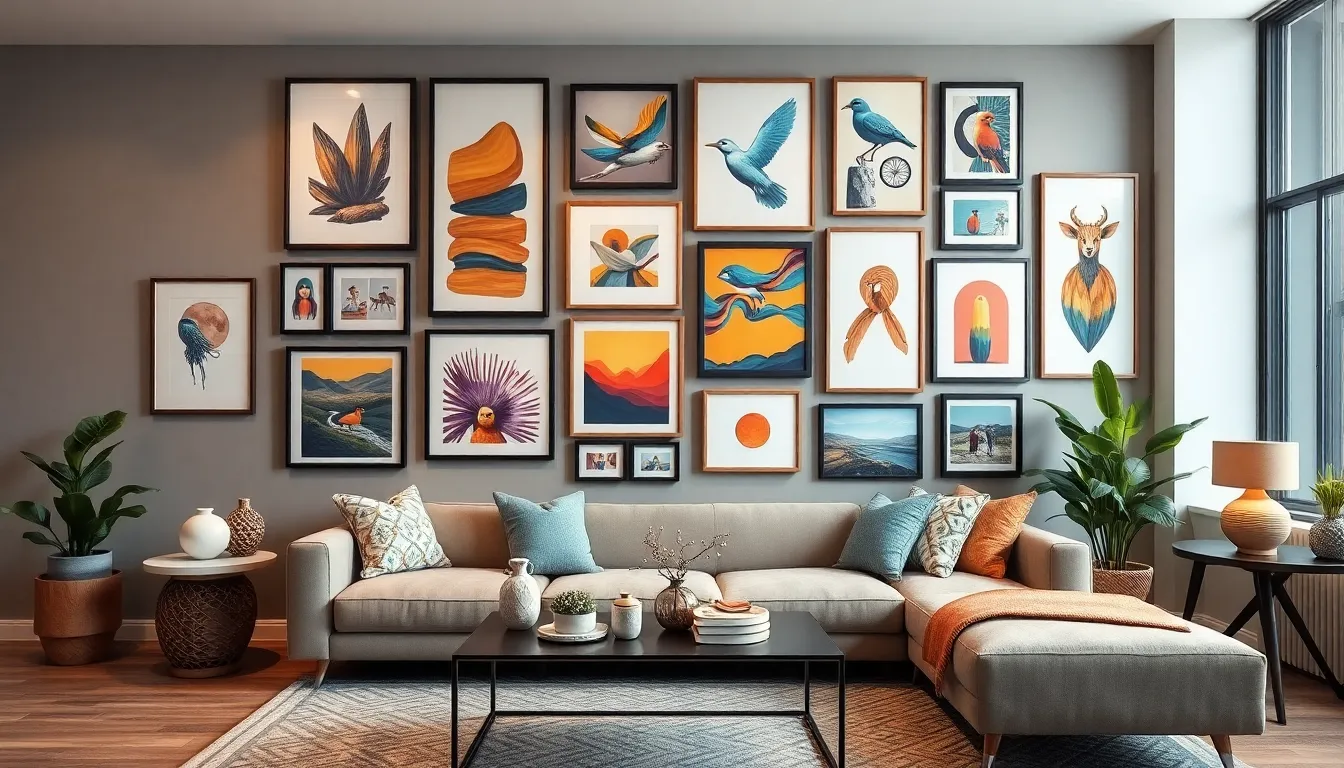
Creating visual interest through varied dimensions transforms your living room gallery wall from ordinary to extraordinary. The key lies in thoughtfully combining different proportions and forms to achieve a ever-changing yet harmonious display.
Combine Large Statement Pieces With Smaller Accents
Large statement pieces serve as anchor points that draw the eye and establish focal areas within your gallery wall arrangement. We recommend selecting eye-catching prints or paintings as your primary elements, then surrounding them with mini frames and decorative objects to create depth and hierarchy.
Smaller accent pieces fill gaps and provide breathing room around your major artwork. These might include family photographs, small botanical prints, or even three-dimensional objects like small shelves or sculptural elements.
Strategic placement prevents overwhelming your space while ensuring each piece gets proper attention. Position your largest artwork slightly off-center, then build clusters of smaller frames around it to create natural visual flow throughout the display.
Use Geometric And Organic Frame Shapes
Geometric frames provide structure and clean lines that work particularly well in modern living rooms. Rectangular and square frames offer classic appeal and easily align with furniture edges and architectural elements.
Organic shapes add softness and prevent your gallery wall from feeling too rigid or monotonous. Oval and circular frames introduce curves that complement the angular elements and create visual rhythm.
Mixing both frame types creates balance between structured and flowing elements. We suggest using geometric frames for your larger pieces and incorporating organic shapes in smaller accent frames to maintain proportion while adding visual interest.
Maintain Visual Balance Across The Display
Visual weight distribution ensures your gallery wall feels stable rather than lopsided or chaotic. Place heavier elements (darker frames, larger pieces) evenly across the wall space to create equilibrium.
Grouping similar sizes together in small clusters within your overall arrangement helps organize the display while maintaining variety. This technique works especially well when you have multiple pieces of the same dimensions.
Off-center placement with complementary surrounding creates the most pleasing arrangements. Position your largest piece away from the exact center, then balance it with groupings of smaller frames on the opposite side to achieve professional-looking results.
Choose The Right Artwork For Your Living Room Style
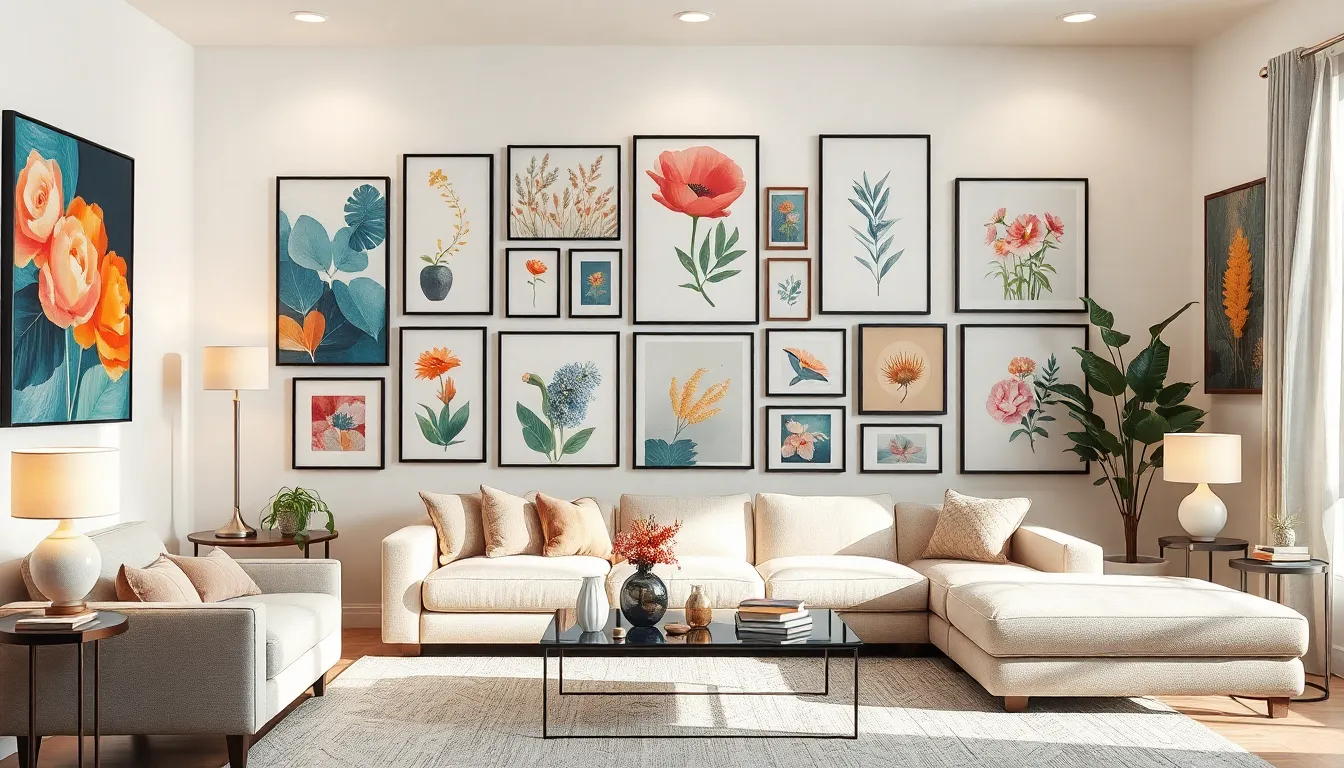
Selecting artwork that resonates with your living room’s design creates a gallery wall that feels intentional and harmonious. We’ll explore how to curate pieces that enhance your space while reflecting your unique personality.
Select Pieces That Reflect Your Personal Taste
Personal taste should guide our primary artwork selection decisions when building a gallery wall. We find that choosing pieces based on our interests and style preferences creates a more authentic and meaningful display than following trends alone.
Meaningful connections to artwork make our gallery walls more captivating for both ourselves and guests. We recommend selecting pieces that tell our story through travel photography, family portraits, or artwork from local artists we admire.
Emotional resonance with chosen pieces ensures long-term satisfaction with our gallery wall investment. We suggest taking time to consider how each potential piece makes us feel rather than rushing into purchases based solely on visual appeal.
Budget considerations shouldn’t limit our personal expression when curating artwork for our living room. We can mix affordable prints with one or two investment pieces, creating a gallery wall that reflects our taste without overspending.
Match Artwork To Your Room’s Aesthetic
Room aesthetic alignment ensures our gallery wall enhances rather than conflicts with our existing living room design. We need to consider our overall design style and color palette when selecting pieces to create visual harmony throughout the space.
Contemporary living rooms benefit from clean lines, abstract pieces, and minimalist photography that complement modern furniture and neutral color schemes. We find that black and white photography or geometric prints work particularly well in these spaces.
Traditional spaces call for classic artwork styles like industry paintings, botanical prints, or vintage photography that echo the room’s established elegance. We recommend choosing pieces with warmer tones that complement rich wood furniture and classic textiles.
Eclectic rooms allow for more creative freedom in artwork selection, letting us mix different styles and periods to create visual interest. We can combine vintage posters with modern photography and abstract paintings to reflect our room’s diverse personality.
Include A Mix Of Photography And Illustrations
Photography and illustrations combined create a visually appealing mix of textures and styles that adds depth to our gallery wall composition. We find this approach prevents our display from looking too uniform or predictable.
Texture variety emerges when we alternate between smooth photographic prints and textured illustration techniques like watercolors or pen and ink drawings. We recommend balancing these different media types throughout our arrangement rather than clustering them together.
Subject matter diversity keeps our gallery wall interesting by mixing portrait photography with industry illustrations or abstract art with botanical prints. We suggest choosing pieces that complement each other thematically while offering visual contrast.
Scale differences between photographs and illustrations add visual rhythm to our gallery wall when we vary sizes strategically. We can use larger photographic pieces as anchors while incorporating smaller illustrations as accent pieces that fill gaps and create flow.
Incorporate Personal Photos And Meaningful Pieces

Transforming your gallery wall from a simple art display into a deeply personal space happens when you include elements that tell your unique story. Personal touches create emotional connections that make your living room feel truly yours.
Display Family Portraits And Travel Memories
Family portraits serve as the heart of any personal gallery wall arrangement. We recommend mixing professional family photos with candid snapshots to create visual variety and authentic storytelling. Travel photographs add worldly sophistication while showcasing your adventures and experiences.
Arrange these meaningful images using either symmetrical layouts for formal living rooms or eclectic arrangements for casual family spaces. Large family portraits work best as anchor pieces, while smaller travel photos fill in gaps and add layers of interest. Frame your travel memories in coordinating materials to maintain visual cohesion across different destinations and time periods.
Consider grouping travel photos by region or experience to create mini-collections within your larger gallery wall. Wedding photos, graduation pictures, and milestone celebrations deserve prominent placement as conversation starters that guests naturally gravitate toward.
Add Sentimental Items Like Letters Or Postcards
Sentimental items bring three-dimensional depth and authentic storytelling to your gallery wall display. Letters from loved ones, vintage postcards, and handwritten notes create intimate focal points that spark meaningful conversations. We suggest framing these delicate pieces using archival materials to preserve them while making them gallery-worthy.
Mix postcards with other artwork to add texture and personal history to your arrangement. Handwritten recipes from grandparents, concert tickets from memorable dates, and childhood drawings from your kids transform ordinary wall space into a family memory showcase.
Shadow boxes work perfectly for displaying thicker mementos like dried flowers, small trinkets, or fabric pieces that hold special significance. These dimensional elements break up flat artwork and add visual intrigue that draws viewers closer to examine the details.
Create A Story Through Your Art Selection
Themed gallery walls tell cohesive stories that reflect your passions and experiences. Travel-themed arrangements might include maps, destination photos, and cultural artifacts that chronicle your journeys together. We recommend starting with a central theme and selecting supporting pieces that enhance rather than compete with your narrative.
Mixed media combinations create the most compelling storytelling opportunities in gallery wall displays. Combine paintings with photographs, prints with three-dimensional objects, and vintage pieces with contemporary artwork to build layers of meaning. Each piece should contribute to your overall story while maintaining visual harmony through consistent framing or color connections.
Consider chronological arrangements that show evolution over time, such as family growth, artistic development, or life milestones. These progressive displays create natural conversation flows and help guests understand your personal journey through visual storytelling.
Use Proper Lighting To Highlight Your Gallery Wall

Effective lighting transforms your carefully curated gallery wall from a simple collection of artwork into a striking focal point that commands attention throughout your living room.
Install Picture Lights For Individual Pieces
Picture lights create dramatic spotlight effects that draw attention to your most treasured artwork pieces. We recommend mounting individual lights above or below each frame to provide focused illumination that enhances colors and details without creating harsh shadows.
Adjustable picture lights offer flexibility to direct light precisely where you need it most. Battery-operated LED picture lights eliminate the need for electrical work while providing consistent illumination for your gallery wall display.
Position lights at a 30-degree angle from the artwork surface to minimize glare and reflections. This positioning technique ensures optimal viewing while protecting your pieces from potential light damage over extended periods.
Position Track Lighting For Even Coverage
Track lighting systems provide comprehensive illumination across your entire gallery wall arrangement without the need for multiple individual fixtures. We suggest installing adjustable track heads that can be repositioned as you update or rearrange your artwork collection.
LED track lights offer energy efficiency while delivering consistent color temperature that won’t distort your artwork’s true colors. Position track lighting approximately 2 to 3 feet away from the wall to achieve optimal coverage without creating unwanted shadows between frames.
Dimmer controls allow you to adjust lighting intensity based on the time of day and your living room’s ambient lighting conditions. This flexibility ensures your gallery wall remains perfectly illuminated whether you’re entertaining guests or enjoying quiet evening moments.
Consider Natural Light Sources
Natural light provides the most authentic illumination for viewing artwork while eliminating ongoing electricity costs for your gallery wall display. We recommend positioning your gallery wall near windows to maximize daylight exposure during peak viewing hours.
Avoid placing artwork in direct sunlight to prevent fading and UV damage over time. East-facing walls receive gentle morning light that enhances artwork visibility without the harsh intensity of afternoon sun exposure.
Window treatments like sheer curtains or adjustable blinds help you control natural light intensity throughout the day. This approach allows you to balance adequate illumination with protection for your valuable artwork pieces while maintaining your living room’s overall aesthetic appeal.
Maintain Consistent Spacing Between Frames
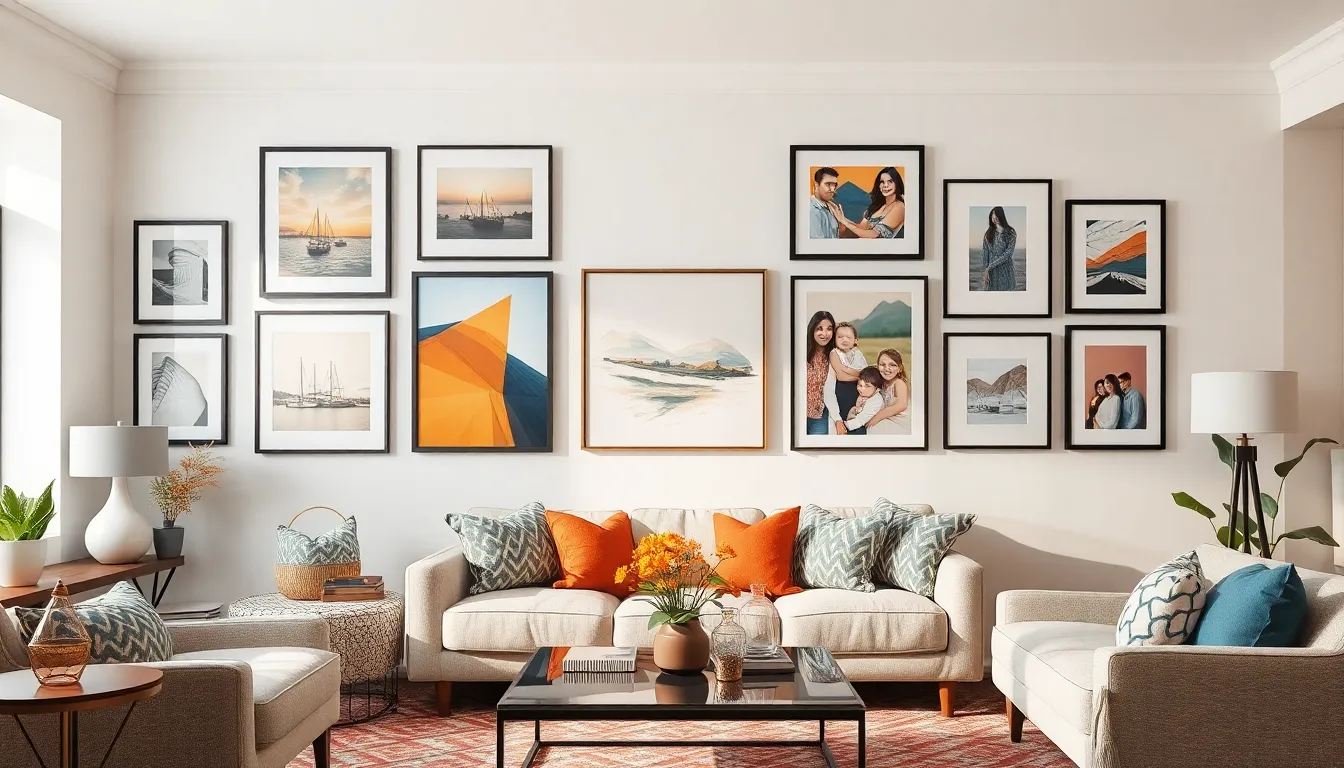
Once you’ve selected your artwork and planned your layout, proper spacing becomes the foundation of a professional-looking gallery wall display. The distance between frames creates visual breathing room that allows each piece to stand out while maintaining overall cohesion.
Keep 2-3 Inches Between Each Frame
Maintaining 2-3 inches of space between frames creates the perfect balance for your living room gallery wall. This spacing distance prevents your artwork from competing for attention while ensuring the display feels unified rather than scattered.
We recommend measuring this distance carefully using a ruler or tape measure for consistency across your entire arrangement. Smaller spaces under 2 inches can make your gallery wall feel cramped and overwhelming to viewers. Larger gaps exceeding 3 inches often create disconnection between pieces and reduce the wall’s visual impact.
Different frame sizes may require slight spacing adjustments to maintain visual balance throughout your display. Large statement pieces can handle slightly wider spacing of 3-4 inches when paired with smaller accent frames. Mixed media arrangements benefit from consistent 2.5-inch spacing that accommodates various frame depths and styles.
Align Pieces At Eye Level
Positioning your gallery wall at eye level ensures comfortable viewing and creates natural focal points in your living room space. The center of your arrangement should sit approximately 57-60 inches from the floor for optimal viewing height.
We suggest measuring from the floor to determine your eye level reference point before hanging any frames. This measurement accounts for average adult height and creates comfortable viewing angles for most guests. Furniture placement below your gallery wall may require slight height adjustments to maintain visual harmony.
Single large pieces should have their centers at the 57-60 inch mark for proper positioning. Multi-piece arrangements need their collective center point aligned at this height rather than individual frame centers. Stairway gallery walls require stepping the eye level measurement to follow the stair’s natural incline.
Create Symmetry In Your Arrangement
Symmetrical arrangements provide structure and visual calm that complements most living room design styles effectively. We achieve symmetry by using a central axis or focal point to balance the visual weight of frames on either side.
Perfect symmetry involves matching frame sizes and spacing exactly on both sides of your central point. This approach works exceptionally well for formal living rooms and traditional decor styles that emphasize order and balance. Asymmetrical balance offers more flexibility while still maintaining visual harmony through careful weight distribution.
Grid-based symmetry creates clean lines using uniform frame sizes arranged in perfect rows and columns. Organic symmetry balances different sized frames by matching visual weight rather than exact dimensions across your arrangement. We recommend sketching your layout first to ensure proper symmetrical balance before committing to wall placement.
Add Texture With Mixed Media Elements
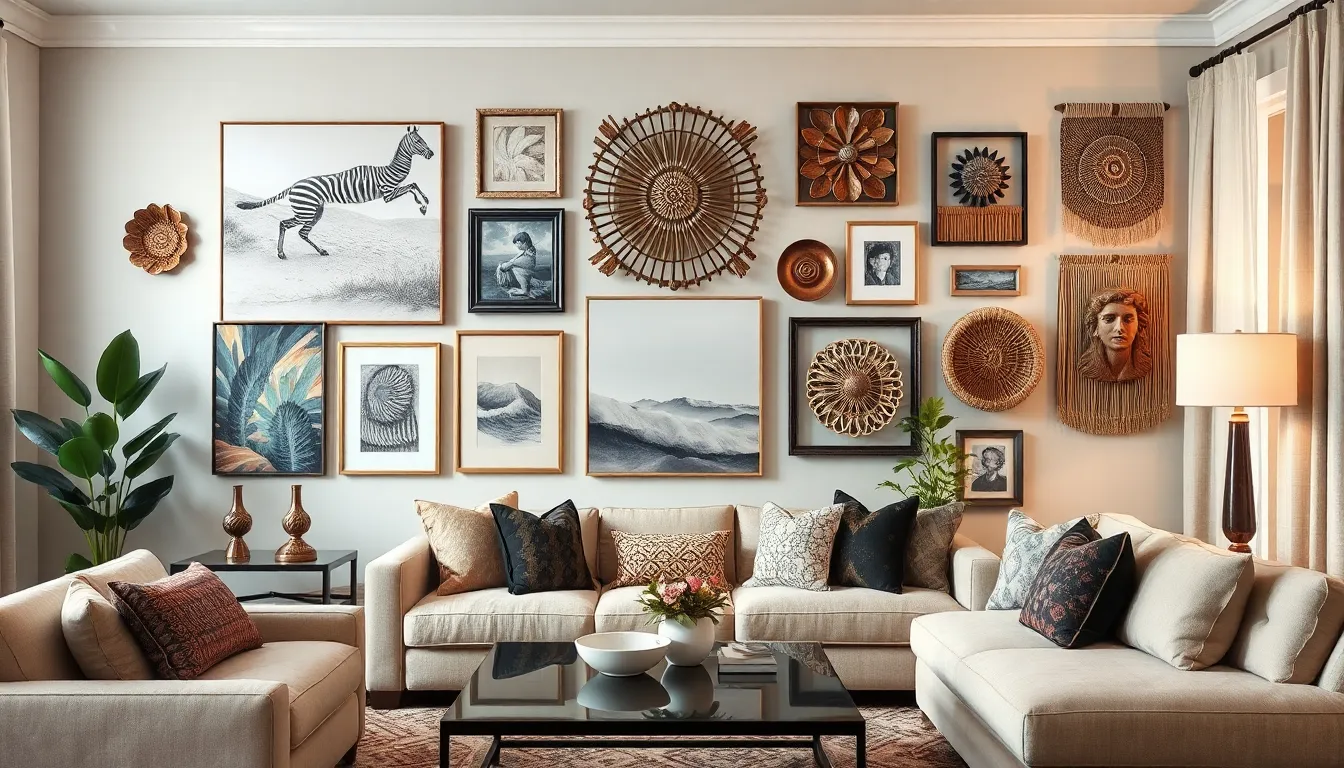
Moving beyond traditional framed artwork creates visual depth and tactile interest that transforms your gallery wall from flat to ever-changing.
Include Canvas Prints And Metal Art
Canvas prints bring elegant sophistication to your living room gallery wall while adding subtle texture through their fabric surface. We recommend choosing canvas pieces featuring artwork or photography that complements your existing color scheme. Metal art pieces introduce contemporary flair through geometric shapes and abstract designs that catch and reflect light beautifully.
Combining these materials creates striking contrast that draws the eye across your display. Canvas prints work exceptionally well as anchor pieces due to their substantial presence, while smaller metal elements serve as brilliant accent pieces. Modern homes particularly benefit from this pairing, as the sleek metal surfaces complement contemporary furniture and fixtures.
Incorporate Woven Pieces Or Tapestries
Woven wall hangings add warmth and organic texture that softens the hard edges of traditional frames. Tapestries introduce rich patterns and colors that can tie together various elements in your living room design. We suggest positioning these textile pieces strategically to break up rows of framed artwork and create visual rhythm.
Woven baskets serve dual purposes as both decorative elements and unique frames for smaller pieces. Natural fiber pieces like jute or rattan baskets complement rustic and bohemian design styles while adding three dimensional interest. Macrame wall hangings create flowing, organic shapes that contrast beautifully with geometric frames and structured artwork.
Mix Flat And Three-Dimensional Elements
Shadow boxes display three dimensional objects like sculptures, collectibles, or meaningful mementos that tell your personal story. We recommend using shadow boxes of varying depths to create layered visual interest across your gallery wall. These display cases work perfectly for showcasing travel souvenirs, vintage finds, or small art objects.
Layered frames create depth by stacking pieces at different distances from the wall. Floating frames add modern sophistication while creating the illusion that artwork hovers above the wall surface. Small shelves integrated into your gallery wall provide platforms for displaying sculptures, plants, or decorative objects that extend the composition into your living space.
Consider Your Living Room’s Focal Points

Strategic placement transforms your gallery wall from simple decoration into a commanding design element that enhances your entire living space.
Position Gallery Walls Away From TV Glare
Glare ruins the visual impact of your carefully curated gallery wall and makes artwork difficult to appreciate. We recommend positioning your display on walls perpendicular to your television rather than directly adjacent to it. Television screens create reflective light that washes out frames and artwork, particularly during daytime viewing when natural light combines with screen brightness.
Corner walls offer excellent alternatives that maintain clear sightlines while eliminating glare issues entirely. We’ve found that gallery walls positioned at 90-degree angles from entertainment centers actually enhance the room’s visual flow. Side walls flanking your seating area provide optimal viewing angles without competing with screen brightness during movie nights or daily viewing.
Use Walls Behind Sofas Or Accent Chairs
Sofa walls create natural focal points that anchor your seating arrangement while providing the perfect backdrop for your gallery display. We position gallery walls approximately 6-8 inches above sofa backs to create visual connection without overwhelming the furniture. Accent chair areas benefit from smaller, more intimate gallery arrangements that complement the chair’s scale and purpose.
Living room layouts with floating furniture arrangements offer prime real estate for statement gallery walls that define conversation areas. We recommend measuring your sofa width and extending your gallery wall 12-24 inches beyond each end for balanced proportions. Sectional sofas provide expansive wall space that accommodates larger gallery arrangements spanning 6-8 feet or more.
Chair groupings work beautifully with vertical gallery arrangements that draw the eye upward and create intimate viewing experiences. We suggest keeping gallery walls behind accent chairs to 36-48 inches wide to maintain proper scale relationships.
Avoid Competing With Other Decorative Elements
Fireplace mantels already serve as natural focal points, so we position gallery walls on adjacent walls rather than directly above or competing for attention. Strong architectural features like built-in bookcases or large windows should guide your gallery wall placement to complement rather than compete. Statement artwork requires careful consideration when planning additional wall displays in the same room.
Design balance comes from distributing visual weight evenly throughout your living space rather than clustering all decorative elements in one area. We recommend the 60-30-10 rule where your gallery wall claims 60% of the visual attention, existing features take 30%, and accent pieces fill the remaining 10%. Multiple focal points work when they’re positioned to create visual triangles that guide the eye naturally around the room.
Existing collections like pottery displays or sculptural pieces should inform your gallery wall’s intensity and scale to maintain harmony. We avoid placing busy, eclectic gallery walls near equally complex decorative arrangements that could create visual chaos.
Start Small And Expand Your Collection Over Time
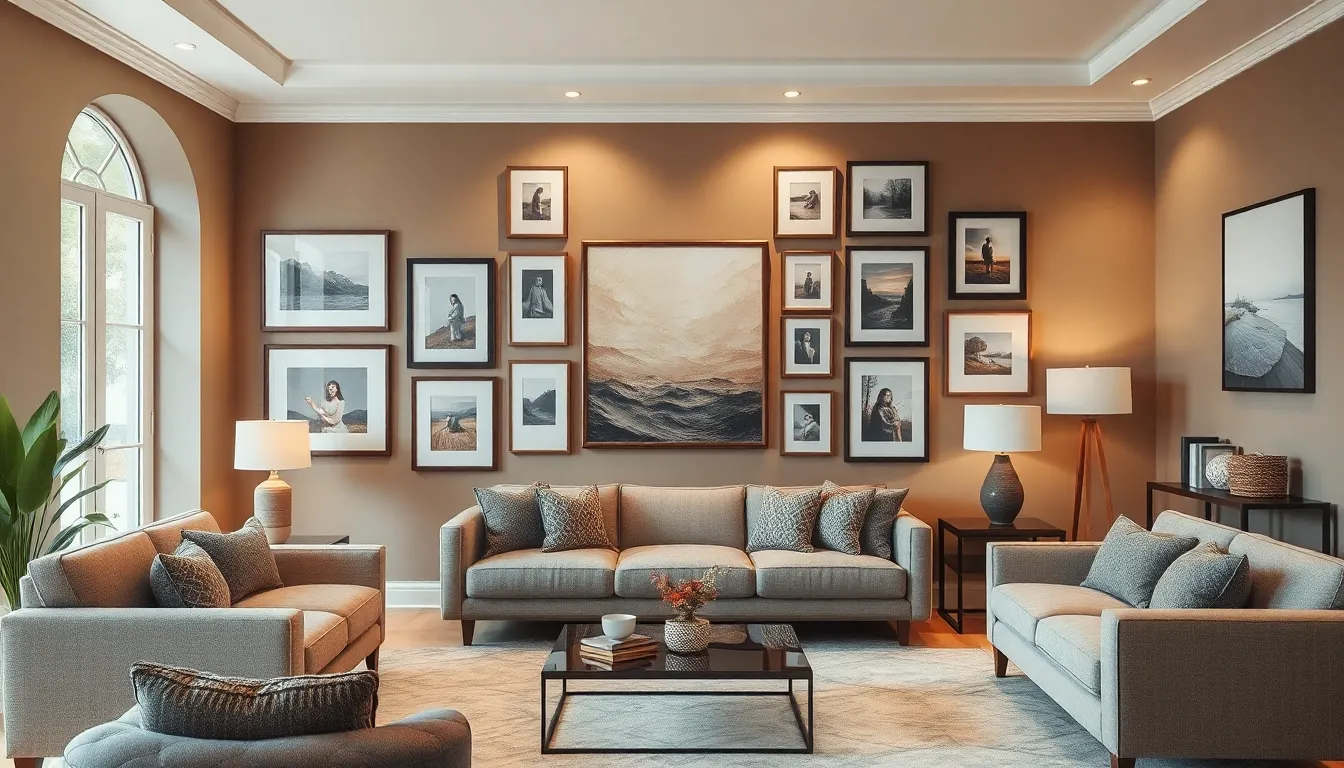
Building a gallery wall doesn’t require completing everything at once. We recommend starting with a thoughtful foundation and growing your collection organically as your style develops.
Begin With A Few Key Pieces
Choose 3-5 meaningful artworks that truly resonate with your personal taste when starting your gallery wall journey. Starting with fewer pieces allows you to focus on quality selections rather than rushing to fill empty wall space.
Select one larger statement piece measuring 11″x14″ or similar as your anchor artwork. This foundational piece establishes the visual weight and style direction for your entire gallery wall display.
Pick complementary smaller pieces in sizes like 8″x10″ or 3″x3″ to support your main artwork. These supporting pieces should share common elements with your anchor piece through color palette, subject matter, or framing style.
Focus on artwork that holds personal significance rather than buying pieces just to fill space. We find that starting with meaningful selections creates a more authentic foundation that you’ll love for years to come.
Add New Artwork Gradually
Introduce one or two new pieces every few months to allow your collection to grow naturally. This gradual approach prevents overwhelming your space while giving you time to find pieces that truly complement your existing display.
Look for artwork that enhances your current arrangement rather than competing with established pieces. Each new addition should strengthen the overall visual story you’re telling through your gallery wall.
Consider seasonal additions that can refresh your display without permanent changes. We suggest incorporating removable pieces that can rotate in and out as your preferences evolve.
Shop with patience and intention rather than making impulse purchases. The best gallery walls develop over time through thoughtful curation rather than rushed decisions.
Rearrange As Your Style Evolves
Refresh your gallery wall arrangement every 3-6 months to keep the display feeling current and captivating. Moving pieces to different positions breathes new life into familiar artwork without requiring new purchases.
Experiment with different groupings as you add new pieces to your collection. What worked initially may need adjustment as your gallery wall grows and your aesthetic preferences mature.
Rotate pieces between different rooms or storage to give your living room gallery wall a fresh perspective. This rotation strategy maximizes your artwork investment while preventing visual fatigue.
Document your favorite arrangements with photos before making changes. We recommend keeping a visual record of successful layouts that you can reference or recreate in the future.
Conclusion
Creating the perfect gallery wall for your living room doesn’t have to feel overwhelming. With these proven strategies we’ve shared you’re well-equipped to design a display that reflects your unique style and personality.
Remember that your gallery wall is a living element of your home that can evolve alongside your tastes and experiences. Start with pieces that speak to you and don’t be afraid to experiment with different arrangements until you find what feels right.
The key to success lies in thoughtful planning proper spacing and choosing artwork that creates meaningful connections in your space. Your living room gallery wall should tell your story while improving the overall aesthetic of your home.
Take your time enjoy the process and watch as your carefully curated gallery wall becomes a conversation starter that brings joy to both you and your guests for years to come.
Frequently Asked Questions
What is a gallery wall and why should I create one in my living room?
A gallery wall is a curated collection of artwork, photos, and decorative pieces arranged on a wall to create visual interest and personality. It transforms your living room into a more inviting and aesthetically pleasing space while showcasing your personal style and meaningful memories.
How do I choose the right color scheme for my gallery wall?
Establish a unified color palette of 3-4 colors with one dominant color making up 60% of the display. Use consistent framing to tie pieces together, balance bold and neutral tones, and incorporate existing living room colors from furniture, decor, and wall paint for cohesion.
Should I plan my gallery wall layout before hanging?
Yes, always plan your layout first. Measure your wall space accurately, create paper templates for each frame, and test different arrangements on the floor. This prevents mistakes, unnecessary nail holes, and ensures proper spacing and visual balance before committing to wall placement.
What frame sizes and shapes work best for gallery walls?
Mix different frame sizes and shapes to create visual interest. Combine large statement pieces with smaller accents, use geometric frames for structure and organic shapes for softness. Distribute heavier elements evenly and group similar sizes together for professional-looking balance.
How do I select artwork that matches my living room style?
Choose pieces that resonate emotionally and reflect your personal taste. Match artwork to your room’s aesthetic (contemporary, traditional, or eclectic), include a mix of photography and illustrations, and vary the scale with larger pieces as anchors and smaller ones as accents.
Can I include personal photos in my gallery wall?
Absolutely! Personal photos make gallery walls more meaningful. Mix family portraits with travel memories, combine professional and candid shots, and include sentimental items like letters or postcards. Create themed displays that reflect your passions and experiences for deeper personal connection.
What lighting works best for gallery walls?
Use picture lights to spotlight individual pieces with adjustable LED options, or install track lighting for even coverage. Position lights at a 30-degree angle to minimize glare and use dimmer controls. Natural light near windows is beneficial, but avoid direct sunlight to prevent fading.
How much space should I leave between frames?
Maintain consistent spacing of 2-3 inches between frames to create visual breathing room and cohesion. This prevents cramped appearances while keeping the arrangement connected. Measure carefully and use templates to ensure even spacing throughout your display.
Where should I hang my gallery wall at the right height?
Position the center of your gallery wall arrangement at 57-60 inches from the floor for optimal eye-level viewing. This standard height works for most people and creates comfortable viewing angles while maintaining professional gallery aesthetics.
How can I add texture and dimension to my gallery wall?
Incorporate mixed media elements like canvas prints, metal art, woven pieces, or tapestries. Mix flat artwork with three-dimensional elements such as shadow boxes and layered frames. This creates visual depth, breaks up monotony, and adds tactile interest to your display.
Where should I position my gallery wall in the living room?
Place gallery walls away from TV glare and on walls that complement existing focal points. Position them 6-8 inches above sofa backs, extend beyond sectional width for proportion, and avoid competing with fireplaces or built-ins. Create visual triangles for natural eye movement.
Should I create my entire gallery wall at once?
Start small with 3-5 meaningful pieces including one larger anchor piece, then gradually expand every few months. This allows thoughtful curation without overwhelming the space. Rearrange every 3-6 months to keep the display fresh and document arrangements to maintain cohesive aesthetics.

